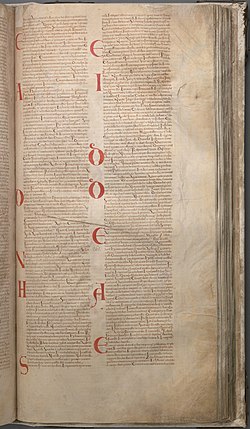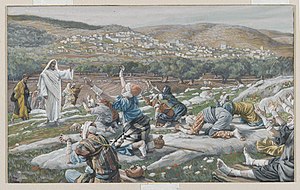Luke 17
| Luke 17 | |
|---|---|
 The Latin text of Luke 14:30–19:7 in Codex Gigas (13th century). | |
| Book | Gospel of Luke |
| Category | Gospel |
| Christian Bible part | New Testament |
| Order in the Christian part | 3 |
Luke 17 is the seventeenth chapter of the Gospel of Luke in the New Testament of the Christian Bible. It records the teachings of Jesus Christ and the healing of ten lepers.[1] The book containing this chapter is anonymous, but early Christian tradition uniformly affirmed that Luke composed this Gospel as well as the Acts of the Apostles.[2]
Text[]
The original text was written in Koine Greek. This chapter is divided into 37 verses.
Textual witnesses[]
Some early manuscripts containing the text of this chapter are:
- Papyrus 75 (175-225)
- Papyrus 111 (3rd-century)
- Codex Vaticanus (325-350)
- Codex Sinaiticus (330-360)
- Codex Bezae (~400)
- Codex Washingtonianus (~400)
- Codex Alexandrinus (400-440).
Offences and forgiving of offences (17:1–10)[]
- Then He [Jesus] said to the disciples, “It is impossible that no offenses should come, but woe to him through whom they do come!"[3]
Jesus warns of "offences" coming, literally "stumbling blocks" (Greek: τα σκανδαλα, skandala).[4] Other translations used are "obstacles" (Jerusalem Bible) and "temptations to sin" (English Standard Version). Reflecting on Jesus' assertion that something might be "impossible", Lutheran Pietist Johann Bengel offers as alternative readings, "it is not a thing usual to happen" or "a thing not admissible in the common course of things", noting similarly that at Luke 13:33 Jesus had said that "it is impossible for a prophet to be killed outside of Jerusalem".[5][6]
Cleansing ten lepers (17:11–19)[]

This is one of the miracles of Jesus in the Gospels (only in the Gospel of Luke).[7][8] On his way to Jerusalem, Jesus traveled along the border between Samaria and Galilee. As he was going into a village, ten men who had leprosy met him. They stood at a distance and called out in a loud voice, "Jesus, Master, have pity on us!" When he saw them, he said: :"Go, show yourselves to the priests." And as they went, they were cleansed. One of them, when he saw he was healed, came back, praising God in a loud voice. He threw himself at Jesus' feet and thanked him—and he was a Samaritan. Jesus asked:
- "Were not all ten cleansed? Where are the other nine? Was no one found to return and give praise to God except this foreigner?"
Then he said to him:
- "Rise and go; your faith has saved you."
This miracle has been described as emphasising the importance of faith, for Jesus did not say: "My power has saved you" but attributed the healing to the faith of the beneficiaries.[9][10]
The coming of the kingdom (17:20–21)[]
Verse 20[]
- Now when He was asked by the Pharisees when the kingdom of God would come, He answered them and said, "The kingdom of God does not come with observation;"[11]
Verse 21[]
- Neither shall they say, Lo here! or, lo there! for, behold, the kingdom of God is within you.[12]
Lutheran biblical writer Harold Buls notes that the Pharisees' question is a 'when?' question whereas Jesus' answer is a 'what?' response: the Pharisees "were expecting the Kingdom of God ... to come soon"; this is "a faulty notion about the character of the Kingdom". Jesus replies that the Kingdom of God does not come "with observation" or "with a visible display":[13] the word Greek: παρατηρήσεως (paratērēseōs, careful observation) appears only here in the New Testament.[14]
The day of the Son of Man (17:22-37)[]
The discourse in Luke 17:22–37 is proper to this gospel. Luke handles the "end of time" in a different manner from Matthew, whose "discourse on the end times" makes use of similar material. Luke makes a clear distinction between Jesus' prophecy of the destruction of Jerusalem (see Luke 21:6–24) and his own coming in glory at the end of time.[15]
See also[]
- Leper
- Lot
- Ministry of Jesus
- Miracles of Jesus
- Noah
- Samaritan
- The Kingdom of God is Within You
- Other related Bible parts: Genesis 6, Genesis 7, Genesis 19, Leviticus 14, 2 Kings 5, Matthew 24
References[]
- ^ Halley, Henry Hampton (1965). Halley's Bible handbook : an abbreviated Bible commentary (24th ed.). Grand Rapids: Zondervan. p. 516.
- ^ E. Ray Clendenen; Jeremy Royal Howard, eds. (2015). The Holman Illustrated Bible Commentary. B&H Publishing Group. ISBN 978-0-8054-9930-8.
- ^ Luke 17:1: NKJV
- ^ Luke 17:1: Textus Receptus
- ^ Luke 13:33: New Revised Standard Version
- ^ Bengel, J. A., Bengel's Gnomon of the New Testament on Luke 17, accessed 5 August 2020
- ^ Evans, Craig A. (2003). The Bible Knowledge Background Commentary: Matthew-Luke. 365. David C Cook. ISBN 978-0-7814-3868-1.
- ^ Luke 17:11–19: NIV
- ^ Marthaler, Berard L. (1993). The Creed: The Apostolic Faith in Contemporary Theology. 220. Twenty-Third Publications. ISBN 978-0-89622-537-4.
- ^ Lockyer, Herbert (1988). All the Miracles of the Bible. Harper Collins. p. 235. ISBN 978-0-310-28101-6.
- ^ Luke 17:20 NKJV
- ^ Luke 17:21 KJV
- ^ Luke 17:20: ISV
- ^ Englishman's Concordance, παρατηρήσεως
- ^ Jerusalem Bible (1966), footnote e at Luke 17:22
External links[]
- Luke 17 King James Bible - Wikisource
- English Translation with Parallel Latin Vulgate
- Online Bible at GospelHall.org (ESV, KJV, Darby, American Standard Version, Bible in Basic English)
- Multiple bible versions at Bible Gateway (NKJV, NIV, NRSV etc.)
| Preceded by Luke 16 |
Chapters of the Bible Gospel of Luke |
Succeeded by Luke 18 |
- Gospel of Luke chapters